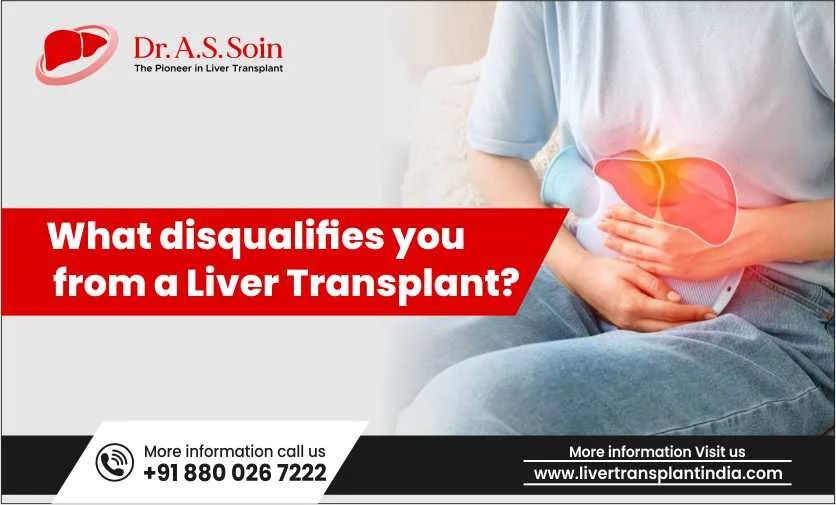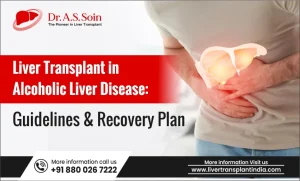Liver transplantation remains a cornerstone and often life-saving intervention for end-stage liver diseases. Yet, not everyone who requires a transplant is eligible immediately. Recent advancements highlight both expanded opportunities and updated exclusions, ensuring each donor organ is used with maximum benefit and fairness.
Table of Contents
ToggleWhy Are Eligibility and Disqualification Criteria Evolving?
Modern transplant systems focus increasingly on ethical allocation, long-term outcomes, and justice. New clinical guidelines, like the 2024-2025 EASL recommendations and major US updates, now incorporate:
- Broader medical indications (including acute severe alcohol-related hepatitis and selected cancers)
- Enhanced focus on frailty, sarcopenia, cardiovascular risk, and equity of access
- New technologies for organ assessment and preservation
- Updated strategies for patient monitoring and re-evaluation
Key Disqualification Factors
1. Active, Untreated Alcohol or Substance Abuse
While historic practice required 6 months of sobriety for patients with alcohol-related liver disease, current approaches stress individual assessments. Early transplants for severe alcoholic hepatitis may be considered if patients show strong social support and commitment, although ongoing substance use remains a strong temporary contraindication.
Substance abuse (including opioids, cocaine, IV drugs) without monitored rehabilitation or participation in addiction medicine programs generally results in listing denial.
2. Active or Recent Malignancy Outside the Liver
Immunosuppressive therapy post-transplant can accelerate https://www.whitendry.com/BookNow/ cancer recurrence. Active, metastatic, or recently treated extrahepatic cancers—except for a few low-risk, well-managed exceptions—are grounds for disqualification. However, guidelines now allow transplant consideration for carefully selected, limited non-hepatic tumors such as small intrahepatic cholangiocarcinoma, some neuroendocrine tumors, and even certain colorectal liver metastases, providing disease stability for 6 or more months after successful treatment and with ongoing intensive monitoring.
3. Advanced, Irreversible Cardio-Pulmonary Disease
Severe heart disease, advanced pulmonary hypertension (>50mmHg mean pulmonary artery pressure), severe arrhythmias, or poor cardiac function remain absolute contraindications due to high surgical risk. Rigorous cardiac assessment—including stress tests and right heart catheterization—are now routine for all candidates.
4. Uncontrolled Infections
Any systemic, uncontrolled infections (e.g., sepsis, uncontrolled tuberculosis, untreated HIV with high viral load, severe viral hepatitis, or resistant fungal infections) prevent safe transplantation. Treatment and stabilization are prerequisites for re-listing.
5. Severe Frailty, Malnutrition, or Debility
The latest guidelines highlight physical frailty and sarcopenia (muscle wasting) as major predictors for transplant outcomes—not just malnutrition as measured by BMI or albumin levels. Multidisciplinary interventions such as nutrition optimization, exercise, and rehabilitation can make previously disqualified patients eligible again.
6. Unmanaged, Severe Psychiatric Disorders
Uncontrolled psychiatric illness, especially those interfering with consent, compliance, or postoperative care, still poses a major barrier. However, stabilization and demonstrated engagement with mental health services often restores eligibility.
7. History of Non-Compliance
Past evidence of missed appointments, poor medication adherence, or neglecting lifestyle recommendations flag high relapse risk. Modern transplant teams actively work with patients—including family engagement and social work support—to address these issues, but persistent non-compliance still precludes listing.
8. Lack of Adequate Caregiver or Social Support
A reliable caregiver and support system are considered https://tekape.space/ essential, especially given infection risks and complex medication regimens. Inadequate support may delay but not permanently bar transplantation—social work teams are increasingly helping patients build necessary networks.
9. Severe Obesity (BMI > 40)
Current practice recognizes obesity as a modifiable risk, rather than absolute exclusion. Patients with BMI >40 are evaluated for comorbidities, surgical feasibility, and commitment to weight loss—with structured pre-transplant programs now common.
10. Age: Biological Over Chronological
There is now no strict age cutoff. Patients over 75 are individually assessed, prioritizing physiologic resilience, cognitive health, and independence, rather than age alone.
11. Unfavorable Tumor Biology in Liver Cancers
Modern guidelines have expanded some tumor criteria: patients who do not meet Milan or UCSF criteria, have large tumors, vascular invasion, or extrahepatic spread are generally ineligible. However, successful “downstaging” with therapies can restore eligibility in select cases, and certain advanced cancers (iCCA, NETs, select colorectal metastases) may now be considered in expert centers after 6 months of stable disease.
12. Ongoing Disease Recurrence Risk
If underlying disease—like active hepatitis C (now rarely a barrier thanks to direct-acting antivirals), autoimmune hepatitis, or nonalcoholic steatohepatitis (NASH)—is not well controlled, transplanted livers may fail early. Addressing root causes is vital.
13. New Considerations:
- Sex- and Size-based Disparities: Updated scoring models (e.g., MELD 3.0) now seek to reduce bias against women and smaller candidates.
- Cardiovascular Risk and Frailty: Quantified as independent risks for poor outcomes—central to current eligibility evaluation.
- Ethical Equity: National and international agencies want equity in recipient selection regardless of demographics or socioeconomic status.
14. Additional Relative Exclusions
- Uncontrolled diabetes or hypertension and bleeding diathesis
- Severe renal failure (may prompt combined liver-kidney transplant)
- Irreversible brain damage
- Untreatable severe pulmonary dysfunction
Are Disqualifications Permanent?
No—guidelines increasingly treat even “absolute” disqualifications as temporarily resolvable, pending successful treatment. Many previously ineligible patients become candidates after addressing infections, mental health, nutrition, abstinence, or social support gaps.
When to Seek a Second Opinion?
If you’re declared ineligible, high-volume transplant centers often review “high-risk” or borderline cases and may accept patients turned away elsewhere, especially as guidelines evolve.
Ethical Framework:
Every transplant https://www.supergreensexpert.com/about/ must balance utility (individual patient benefit), equity (fairness across all patients), and justice (wise resource allocation)—guided now by increasingly nuanced, patient-centered methods.
Key Takeaways for 2025:
- Disqualification criteria are increasingly nuanced and reversible.
- New protocols have expanded eligibility for several advanced cancers, acute alcohol hepatitis, and selected high-risk patients.
- Frailty, sarcopenia, and cardiovascular risks are now central in decision-making—address these proactively.
- Collaborative, multidisciplinary care—including rehabilitation and psychological support—is often decisive in restoring eligibility.
- Patients and families should be proactive: ask about ways to regain eligibility, and don’t accept a single “no” as final.
http://tasdeeq.riphahfsd.edu.pk/
At Dr. A.S. Soin’s transplant unit, our team believes in second chances, multidisciplinary healing, and thorough, compassionate evaluation. With the right approach, many patients once considered ineligible eventually go on to receive successful liver transplants and long, healthy lives.








